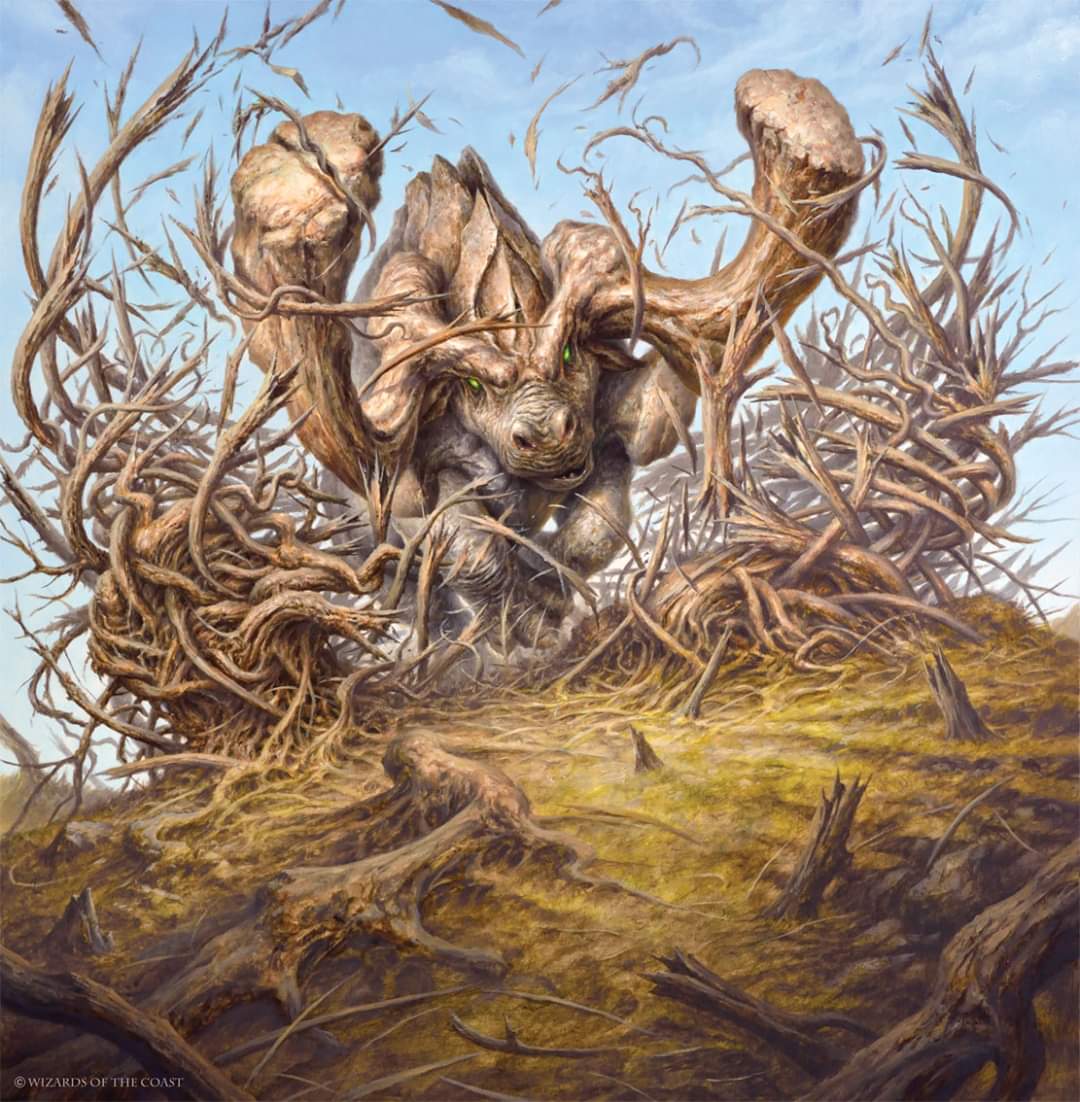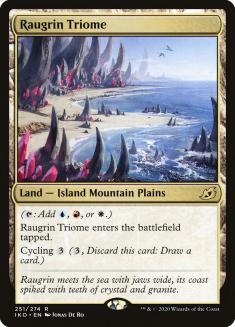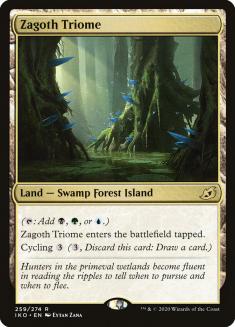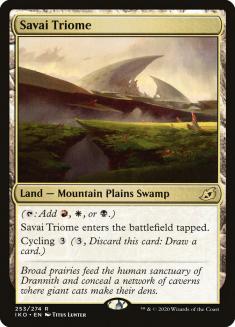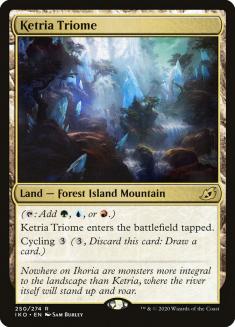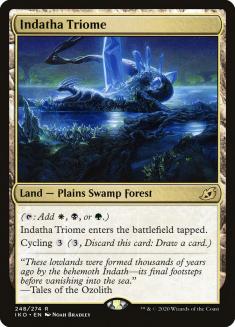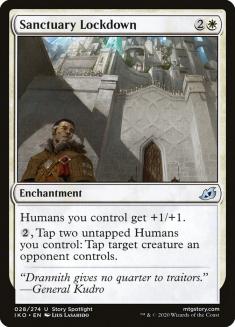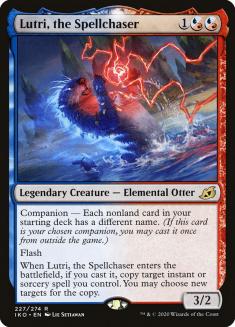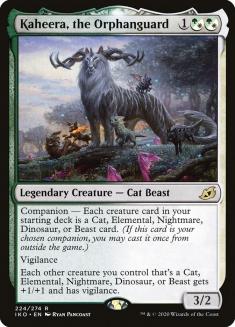Ikoria is an incredibly ambitious set in a lot of ways. The first we saw was the Godzilla crossover, which is a fairly bold new direction for the brand from a business standpoint, but not a big deal to most players. The biggest impact for players has been the introduction of companions, which, as you probably know, I’m not a fan of (after seeing it play out a little more, I think I went too easy on the mechanic). Many have also noted the potential complexity of the introduction of ability counters and the mutate mechanic, and the simple fact that there are a lot of words on Ikoria cards. Beyond all this, I think the design of the Limited environment was also particularly ambitious in somewhat more subtle ways.
I think Ikoria does a lot of brilliant things in its overall set design with regard to Limited play, but mirroring the impact of companions on the set as a whole, I think a lot of that is overshadowed by the implementation of cycling this time around. Before we get into that, I’d like to look at the unique things I think this set does really well.
It’s my understanding that land cycles are planned far in advance in Magic because the availability of nonbasic lands is so fundamental to any given Standard environment. I’m not completely sure about the early set design process, but I think it might be the case that the land cycles are essentially the first cards in a set that are locked in, and in many ways the set is built around which lands it’s supposed to be introducing to Standard. If that’s right — and I don’t have any real inside info here, I’m just guessing — then the set might have been designed from the ground up around the idea that it’s going to have to feature Triomes. Either way, the Triomes were certainly central to Ikoria’s worldbuilding and the set is certainly built around wedges.
Conventionally, we’d expect that to mean it’s probably a gold set, and while this isn’t exactly not a gold set, in that it does have more gold cards than average, it’s certainly not what I’d traditionally call a gold set, in that it has no gold commons and only around twice the normal number of gold uncommons.
Despite that, it still manages to “feel” gold, but in a way that offers a lot more flexibility, which helps minimize a lot of problems with gold sets that I think structurally helps it maintain far better replayability than a Ravnica set, for example.
Ravnica is an interesting structure to consider in thinking about what makes a good Limited format. As I understand it, Ravnica is popular and well-loved. Part of this is that shocklands are powerful and players like them. Part of it is that gold cards get to be pretty flashy for Constructed. Part of it is that the world is pretty awesome and creating solid identities for each color pair was a great idea. Ravnica Limited is very different from most other Limited formats because we typically have three to five playable color combinations instead of ten, and that leads to much less metagame diversity, which should probably make the format stale pretty quickly.
Despite that, I don’t feel like it’s widely hated as a Limited format, and I’m not entirely sure why.
It’s possible that players just like having more direction. It’s also possible that more focus on fewer possible archetypes means that there’s room for multiple sub-archetypes within each color combination, and that because the cards for multiple kinds of builds are all in the same colors, it leads to interesting decisions where you’re presented with a lot of options for minor pivots within a color combination. I’m not entirely sure.
Anyway, I’d argue that this set manages to play similarly, but in a less heavy-handed way, which I think is a feature. I believe the set design team attempted to answer the question, “How do we make a set that encourages playing enemy-color decks and wedges without using gold commons?” and I believe they answered the question pretty well.
The simple answer is that they created decks based around specific mechanics for each enemy-color pair and created single-color cards that go in those decks, and then just didn’t really make decks like that for the allied colors. They cemented this by making a lot of gold uncommons for enemy colors only that lead players to those decks, and also monocolored payoffs for specific enemy-color decks that don’t work well outside of their context, like Sanctuary Lockdown, which is great in Orzhov Humans but pretty bad in any other white deck.
Interestingly, there’s also token support for each allied color pair. They each get one hybrid uncommon and one gold rare that call out a specific keyword, and a mentor that supports that keyword (except for Dimir, where the mentor doesn’t interact with their keyword and instead interacts with lifelink, because the mentor granting flash wouldn’t work, but the break in the cycle bothers me).
The end result here is that, for the most part, allied-color decks aren’t supported, but they do come up occasionally, largely directed by the rares, and when you try to draft one, you have the advantage that they’re so lightly supported that it’s very unlikely that you’ll be competing for the cards you want with anyone else at the table, so the deck can actually come together.
More commonly, if you’re trying to draft two allied colors, you’ll end up splashing their common enemy and playing a wedge, and again, some rares will encourage you to do this. The wedges mostly aren’t supported as particularly coherent decks, but there are enough opportunities for cross-synergies that it works out pretty well.
What all of this means is that clear direction is offered to players to guide them to functional decks in their first few drafts, as there are pretty clear ways to draft straightforward enemy-color decks that do the thing you’re supposed to do in that color pair, but there’s also a lot of room for experienced players to keep drafting the set to explore all the weird corner cases that come up. I’ve drafted more than I end up drafting most other sets lately, and as I write this, I still want to get back to drafting on the outside chance I end up in a spot to further explore Rakdos as a color pair after a failed attempt that followed a first-pick Lutri, the Spellchaser.
I write a strategy column, not a design column, contrary to what my rant about companion may lead you to suspect, and I’m working around to getting to the strategy of drafting Ikoria. I believe the most important thing to understand to approach the Limited format is what’s going on in the set on a big-picture level. This helps identify which cards are there for your deck. You don’t necessarily always want to only play the cards you’re supposed to, but it’s a pretty safe way to end up with something respectable.
I’m expecting most readers have drafted the set at least a few times at this point, so I don’t want to spend too much time spelling out the fundamentals, but just so we’re all on the same page, the basic archetypes that drive the set are:
- Orzhuv Humans
- Izzet Spells (or cycling)
- Golgari “officially” graveyard, but in practice mostly mutate
- Boros Cycling
- Simic Mutate
Now let’s dive a little further into this.
Orzhov Humans
This pair generally ends up playing either as a fairly aggressive go-wide Humans deck or as a removal-heavy control deck.
The go-wide deck is aggressive the way that go-wide decks are aggressive, which means it can play a little like Boros in Theros Beyond Death, which is to say it’s not always just about killing someone quickly; sometimes you just get a bunch of things on the battlefield and then win by pumping them up or something. Sanctuary Lockdown and Bastion of Remembrance are both great here, as are Nightsquad Commando and Daysquad Marshal, though those generally don’t need to be taken especially early. Bushmeat Poacher deserves special note as being excellent here.

The control deck happens when you get enough good removal that you don’t have the creature density to use creature payoffs like Sanctuary Lockdown or Bastion of Remembrance. Without Sanctuary Lockdown there’s no real need to prioritize Humans and there are some strong mutate cards available, so the control deck often ends up specifically skewing away from Humans, so not all Orzhov decks actually end up caring about Humans. Bushmeat Poacher is also great here, especially in conjunction with Durable Coilbug as a way for your control deck to generate card advantage.
Izzet Spells
Red is theoretically split between payoffs for cycling and payoffs for casting spells. On paper, this should be a clear distinction, and in theory, the cycling cards should want to be paired with white and the casting cards should want to be paired with blue. This is the first point that I consider a substantial misstep in the design of this set — the rewards for casting spells just aren’t as good as the rewards for cycling, and the best rewards, Spelleater Wolverine and Blitz of the Thunder-Raptor, don’t care how the cards ended up in your graveyard. Where these mechanics should be at odds because your cards and mana can only be spent triggering Prickly Marmoset or Pyroceratops but not both, in practice, Prickly Marmoset is just a much stronger card that Pyroceratops and Blisterspit Gremlin, so no one uses the casting trigger cards and Izzet ends up being a cycling deck.


Further, because cycling costs colorless mana, it turns out dedicated cycling decks can easily get by with the worst manabases of all time and you can register a deck with six Mountains, three Plains, three Islands, and a Tranquil Cove as its only lands with a straight face.
Golgari “Graveyard”
The joke here is that you can mill a big creature with Excavation Mole or cycle a Greater Sandwurm into your graveyard and then return it to the battlefield with Unbreakable Bond or Back for More. However, those are both uncommons and Excavation Mole is pretty bad, and it’s better to just rely either on cycling or a normal game of Magic to put creatures in your graveyard, so the self-mill part of this archetype doesn’t really come up much and mostly black ends up getting played as a splash in multicolor green mutate decks that sometimes work in a couple of extra cycling creatures to enable their uncommon reanimation spells. There aren’t really common reasons to play a Golgari deck specifically, so in my experience these decks almost always feature at least one extra color.

Boros Cycling
This archetype is fundamentally broken. It’s simply way more powerful and far better supported than the other archetypes. Not only are there just more cards dedicated to paying off cycling than there are for other mechanics, and not only are those payoffs far better than the payoffs for other mechanics, but Boros Cycling as an archetype just steals a bunch of cards from other colors because every card in the set with cycling 1 is really basically a Boros/(Blue) hybrid card. I’d guess a substantial majority of Memory Leaks have been played in decks that can’t cast them.

I always expect most players to know how good this archetype is, but I still sometimes see Zenith Flare (which is in a completely different league from every other common and uncommon) go fifth-pick in Pack 1. That said, it’s much more contested now than it was in the first week, and sometimes you do get completely cut out of it. That said, many great players have successfully forced it for huge numbers of consecutive drafts and I largely think that’s as reliable a strategy as anything else. Personally, I’m happy to take a bomb that puts me in another archetype, but I have the best results when I enter a draft assuming I’m cycling until proven otherwise.
Simic Mutate
Green in a set like this just isn’t fundamentally set up to stick to two colors. Blue and green have most of the payoffs for mutating, but the actual creatures with mutate are evenly spread between the colors. Mutate is interesting in that small amounts of it play just fine — you can play a couple of mutate creatures in a normal deck and it’s not a problem and the cards won’t be unusually weak, but the enabler cards like Essence Symbiote and Pollywog Symbiote are very good if you have a lot of creatures with mutate and very bad otherwise.
Mutate follows an interesting curve where basically the first time you mutate on a creature it’s very good — you get a trigger and your Farfinder or Fertilid becomes much bigger. The second time you mutate it’s often a little less impressive: you get a couple of triggers, but your creature basically stays the same size and you spent your turn without advancing your battlefield too much. Each mutate beyond that tends to get a lot better as you start generating a giant stack of effects. This means that once you reach a critical mass of mutate creatures, you want more mutate creatures more than anything else regardless of what their actual text is because you get your other good abilities again when you use them. Long story short, this deck ends up wanting to splash mutate creatures from other colors almost every time.

That means the best cards are fixing and mutate creatures, which means Migratory Greathorn is probably the best common, but Humble Naturalist gives it a run for its money. When you can’t take fixing or a mutate creature, you want removal. Good removal can come ahead of weak fixing or mutate creatures. The other thing you’re looking for is other good creatures to mutate onto like Pollywog Symbiote, Farfinder, Fertilid, Ivy Elemental, Glimmerbell, and Almighty Brushwagg. Special note: Adventurous Impulse doesn’t get enough respect and is very good in these decks, since it’s basically fixing that also helps find the right pieces for the combo you’re ultimately building.
So those are the core scripted archetypes, but in practice, I think the archetypes play out as:
Jeskai Cycling
Almost always red, can be any mix of blue and white, sometimes ends up leaning a little more into spells and playing counterspells and more removal than cycling would ideally like. I don’t know if this is more likely to happen because the player doesn’t know how to draft cycling or because it’s too contested, but I think it’s strongest when cycling is prioritized.
Multicolor Green Mutate
Sometimes this is just a multicolor pile of bomb rares instead of mutate creatures, and not surprisingly, those decks are a little stronger.
Black Aggro
I don’t know that these decks are really dedicated to aggression, but I think I’ve found them most threatening that way. This encompasses both Orzhov Humans and the less common Rakdos Menace/Sacrifice fringe archetype that tries to go under people. I don’t exactly think the black cards in the set are weak, but strategically it gets a little left out.
Companion
Ten rare slots is a lot. I’m not sure exactly how many companions are opened per draft, but it’s enough that you play against them regularly. Every companion can be played in Limited. Putting blinders on and forcing a draft around one you open isn’t always a recipe for success, but they’re incredibly powerful and I do think it’s worth trying to make any of them work, though some of them are a little tricky and if you don’t know exactly what to look for to make the deck around them work you can get yourself in a lot of trouble.
Because they’re powerful enough to see play, yet have such strong restrictions in some cases, they sometimes end up creating their own archetypes that don’t exist without them. Lurrus of the Dream-Den, for example, enables “Lurrus Control,” which basically looks to generate card advantage with Springjaw Trap or Sleeper Dart, keep Lurrus around with Corpse Churn, cast a lot of removal, and win by attacking with Lurrus and random cheap creatures.
Kaheera, the Orphanguard enables some of the only real traditional aggro decks in the format. There are very few one- and two-mana creatures in this set that attack well, but Garrison Cat and a random two-drop do great work when you’re guaranteed to cast an awesome lord on Turn 3 every game.
If you open a companion you’re not sure how to use, ask yourself what your goals are. Personally, I’m slamming it and hoping to learn something, but if you’re just trying to win matches, you might want to let it slide and try to do some research later. If you haven’t, I recommend giving some thought to how you’d try to make each companion work so that you’re ready if they come up, because it can definitely be tricky to figure out on the fly.
Conclusions
This is a peak “draft decks, not cards” set. Decent rate cards that look like they’re “solid playables” like Ferocious Tigorilla should almost never make your deck. Don’t try to draft this set based on static common rankings — know the archetypes, identify yours, and take cards that make that deck do its thing.
Cycling is an all time great Limited mechanic, but this set caught players talking about how good cycling was and forced us to smoke the whole box, and the result is a single broken archetype rather than cards that slot evenly into decks across the board to slow the format down incrementally and smooth draws to increase consistency. To my mind, this is not what we wanted, and it comes from a combination of way-above-rate cycling payoffs, way-below-rate cycling costs, and the specifically egregious nature of Zenith Flare, which is great at generating non-games where you just spend all your mana cycling and then double Flare someone out of the game before they can kill you because the set in general is pretty slow.
When in doubt, draft cycling. If you don’t know how, here’s a simple guide:
Jeskai Cycling Common/Uncommon Rankings
1. Zenith Flare
2. Ominous Seas
6. Flame Spill
12. Drannith Healer
13. Go for Blood
16. Frostveil Ambush
17. Snare Tactician
18. Fire Prophecy
19. Neutralize
20. Splendor Mare
21. Swallow Whole
22. Lava Serpent
23. Footfall Crater
24. Memory Leak
26. Pacifism
27. Raugrin Crystal
29. Savai Crystal
30. Ketria Crystal
32. Raking Claws
33. Hampering Snare
34. Shredded Sails
This pick order shouldn’t be followed strictly. There are a lot of sub-archetypes within cycling and this tries to hybridize somewhat between Boros, Izzet, and Jeskai cycling decks, though they have slightly different priorities. If you end up more blue, several other cards are reasonable, like Essence Scatter and Convolute.
Also, there’s some amount of balancing payoffs and cyclers that you have to do based on a combination of what you already have and what seems to be going around the table later. I’ve been experimenting with valuing cheap cyclers more highly relative to payoffs, and this list represents a middle ground between what I’ve had success with before and my more extreme experiments to reflect where I expect it to end. Ultimately, the point is that you don’t want to play any normal filler cards and you ideally want ten-plus cards that cycle for one mana, and you should expect to play between twelve and fourteen lands.
I’ve had a lot of fun drafting Ikoria and I’m not done with it. It’s flawed, but all sets are, and finding the flaws is a lot of the fun. Thanks to companion, I don’t imagine I’ll ultimately remember this set fondly, but they’re actually pretty fun in Limited.

